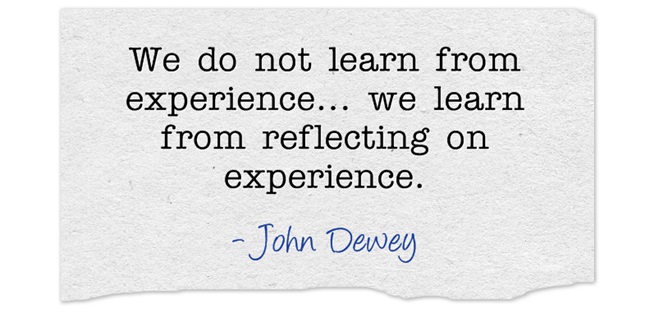“I’m back to back all day.” How often do you get this excuse from people when they are late to your meeting or haven’t replied to your email? I can’t stand this statement – mostly because it passes blame from themselves to the general workplace. Why would I expect a professional to have control over their own schedule? But there’s another concern hiding within this statement. If you spend your days mindlessly moving from meeting to meeting, how much could you possibly be learning along the way? If all you’re doing is doing, when are you taking time to reflect on what you’re doing and how you could do it better?
Reflection is a fundamental part of learning. When you were young and first touched a hot pan on the stove, it wasn’t the pain that taught you it was a bad idea and stopped you from doing it in the future. It was the immediate act of reflection on that pain and it’s cause that did the teaching. In these cases, reflection is almost passive, occurring as an instinctive response. When you remove the survival stakes, reflection is not always immediate or embedded in a task. Rather, it requires dedicated time and effort to explore past actions, extract key insights and prompt behavior change. In a corporate world that always wants more done with less, reflection tends to go by the wayside in favor of more doing. Purposeful embedding of tactics that prompt reflection within the workflow can help us assure the benefits of learning from the work.
Here are 4 proven tactics for promoting reflection as a critical component of workplace learning.
Email Question
Provide employees with the option of subscribing to a reflection question email distribution list. Then, send simple emails each with a single, targeted reflection question. For example: How could you have better handled a recent difficult conversation? Include the question in the title of the message as well as the body to make sure it gets seen and not lost in the email shuffle. Schedule emails to arrive at times that may allow for a few minutes of deep reflection, such as at the end of the day or just before a holiday break. Analyze email data and use short surveys to determine the value of these messages over time.
Daily Huddle
Provide managers who lead daily team huddles with a reflection discussion guide. Include common scenarios and questions meant to evoke conversation and shared experiences. Work with managers and frontline employees to build the discussion guide to make sure its relevant and useful. Deploy the guide in a format that makes it easy to use for the manager. For example, if managers are expected to cover a specific set of topics provided by the home office during the huddle, include the reflection questions as part of this material.
System Prompt
Embed reflection questions within the tools employees use on the job. For example, if your associates use a POS, prompt the system to deploy random, role-specific reflection questions during periods of inactivity. Include a suggestion that the associate take one minute to think about the question and reflect on how they would respond. If employees work in groups, suggest that they briefly share their responses with one another. If technology is not available, post a series of revolving questions in high-visibility areas to prompt the same interactions.
Calendar Block
Ask a corporate administrator to place a 15-minute block on EVERY employee’s calendar for dedicated reflection. Position this block at the end of the typical work day at random intervals. Include a targeted reflection question within the calendar appointment along with a suggested task, such as sharing their responses with the person in the next cubicle or office. Schedule these blocks well in advance and regularly review calendars to ensure this period is not being double-booked.
How do you personally make time for reflection? How would you promote the value of reflection in an organization where people are constantly overwhelmed and under resourced?




